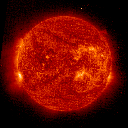"Nevermore!" quoth Elizabeth Gould
 I've felt for some time that John Gould, my Gouldian finch, has been rather lonely sharing this 'umble abode with only your almanackist, who is deep in 15-hour days, seven days a week, of research for a novel he's writing, and has barely enough time to scratch, let alone converse.
I've felt for some time that John Gould, my Gouldian finch, has been rather lonely sharing this 'umble abode with only your almanackist, who is deep in 15-hour days, seven days a week, of research for a novel he's writing, and has barely enough time to scratch, let alone converse.I never could stand to see a lonely bird, so this morning I brought home a red-faced mate for my black-faced fella. As the great ornithologist John Gould named these magnificent small birds for his wife, Elizabeth, my new bird is so named. Welcome, Elzabeth Gould! So pretty.
She's suffered the ignominy of being brought home in a cardboard cake box with holes, has met her new boyfriend, doesn't seem too impressed, and seems inclined to spend the rest of the darkening day sitting alone like Poe's raven, atop not a pallid bust of Pallas but something of that ilk: a silver polystyrene female dummy head I have next to a male one on top of a tall cupboard. She feels safe there and has a good view of the monster beneath her gaze (your almanackist). I'm not sure yet what confidences about me John shared with her in their brief meeting this morning. I hate to think.
Purple-breasted (because he's a he) Johnny, on his favourite driftwood perch near my bathroom mirror is thinking "Women!" and also "How can I crack on to that babe?" and also "Whoaaa!! Did you get a look at that mauve breast??!!". If I remember correctly from my antediluvian youth, he's in there right now endlessly combing his hair but it won't make a scrap of difference. I'll post a photo of the Goulds when I can get (a) a camera, and (b) the two of them in the same place.
 Had a short flaneur and admired the flower of a Banksia integrifolia (pictured). Most of the 75 species of Banksias are commonly called bottlebrushes, for obvious reasons, and I'm a common guy but Banksia will do today. This species is generally called Coast banksia. It likes sandy soils (that, we've got!) anywhere from South Queensland, through new South Wales and into Victoria, and there are three subspecies, which occur in different areas within that range.
Had a short flaneur and admired the flower of a Banksia integrifolia (pictured). Most of the 75 species of Banksias are commonly called bottlebrushes, for obvious reasons, and I'm a common guy but Banksia will do today. This species is generally called Coast banksia. It likes sandy soils (that, we've got!) anywhere from South Queensland, through new South Wales and into Victoria, and there are three subspecies, which occur in different areas within that range.Banksias are named for Sir Joseph Banks (1743 - 1820), the British naturalist and botanist on Captain James Cook's first great voyage (1768 - 1771). He's credited with the introduction to the West of eucalyptus, acacia, mimosa, and the genus named after him, Banksia, all well known species in Australia where his mark was firmly left. He was to be the greatest proponent of settlement in New South Wales, as is hinted by the name Botany Bay, which was the colloquial term for the whole colony before Australia was named.
Banks was directly responsible for several famous voyages, including that of George Vancouver to the Pacific Northwest of North America, and William Bligh's voyages to transplant breadfruit from the South Pacific to the Caribbean Sea islands; the latter brought about the famous mutiny on the Bounty.
Sir Joseph Banks was also adviser to King George III on the Royal Botanic Gardens, Kew, and a prominent Freemason. He published the first Linnean descriptions of the plants and animals of Newfoundland and Labrador. In 1772 he made a voyage to Iceland with the great Swedish botanist Daniel Solander.
Banks’s library, a five-volume catalogue of which was published in his lifetime, became the core of Britain's Natural History Museum Library. His name dots the map of the South Pacific: Bankstown in Australia, Banks Peninsula on South Island, New Zealand, and Banks Island in modern-day Vanuatu.
It's nice to think about such an amazing human being when I see one of the Coast banksia flowers blooming on a warm, bright Saturday afternoon with a big black storm trying to roll in over Sandy. And it's nice to be high and dry with John and Elizabeth Gould, not being tossed about an Arctic sea on Cook's Endeavour. I might have a sandwich and then a nap; maybe dream up the Great Australian Novel.




















 Back in 1825, when 16-year-old Charles Darwin was studying to enter Cambridge University, before even your almanackist was born, a monsieur named Anselme Gaëtan Desmarest was the first to describe a particular crab, Ocypode cordimana, or the Ghost crab -- a bloke we looked at in a recent post. In fact, Monsieur D described a lot of crabs in a life devoted to science (like that of his old man, the geologist
Back in 1825, when 16-year-old Charles Darwin was studying to enter Cambridge University, before even your almanackist was born, a monsieur named Anselme Gaëtan Desmarest was the first to describe a particular crab, Ocypode cordimana, or the Ghost crab -- a bloke we looked at in a recent post. In fact, Monsieur D described a lot of crabs in a life devoted to science (like that of his old man, the geologist 
